NVIDIA’s GeForce GTX 590: Duking It Out For The Single Card King
by Ryan Smith on March 24, 2011 9:00 AM ESTMeet The EVGA GeForce GTX 590 Classified, Cont.
Now that we’ve had a chance to discuss the GTX 590 reference hardware, let’s touch on the rest of EVGA’s package. As we previously noted the EVGA GeForce GTX 590 Classified is being positioned as a premium product with a $30 price premium, so let’s see why.
We’ll start with the box—the box EVGA is using is quite simply enormous. EVGA will be selling both single GTX 590s and pairs of GTX 590s using the same box, so the resulting box is big enough to carry two cards. Presumably this isn’t being sold in any retail stores, as a result the box is nearly blank save for the product name on the front.
In order to sell the idea that this is a premium product, EVGA is also packing in some extras with the card. Honestly there’s probably nothing in here that’s going to be of great utility to you except possibly the mouse pad, but clearly EVGA thinks otherwise:
- EVGA Shirt (XL)
- EVGA Poster
- EVGA Branded Gaming Surface (XL Mouse Pad)
- 2x 6pin-to-8pin PCIe power adaptors
- Display adaptors: DVI-to-VGA, DVI-to-HDMI, miniDP-to-DP
- Driver/demo/utility CD
- Non-generic GTX 590 Quick Start Guide
- Redemption offer for 3DMark 2011 Advanced Edition
EVGA is offering up their usual suite of overclocking tools with the GTX 590, however only EVGA Precision is on the disc. EVGA OC Scanner and ELEET can be downloaded from EVGA’s website.
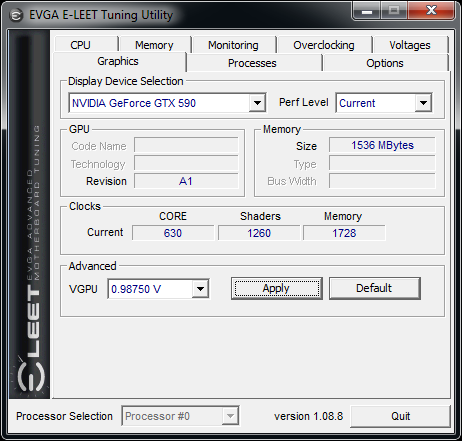
Of the software tools we’ll start with ELEET, as this is the only tool we haven’t covered before. EVGA has had ELEET for some time now for their motherboard business, as it’s their principle motherboard overclocking tool. However at the end of last year they added GPU voltage control through the utility, finally allowing users to overvolt their GPUs using only EVGA tools. We’re glad to see EVGA went with a less-is-more approach with the design of the utility, ditching any funky skinning and focusing on usability. One thing ELEET does that we have not seen on any other utility is that EVGA allows for controlling the voltage for more than just 3D Game clocks; idle and low-performance voltages can also be controlled. We’re assuming the purpose here is to undervolt those modes rather than to overvolt them, as the latter is counterproductive.
At this point ELEET’s only notable weaknesses are related to the fact EVGA implemented voltage control separately from EVGA Precision’s overclocking support. As a result you need to launch ELEET separate from Precision to set any voltages if your overclocked settings require overvolting, and at the moment ELEET does not have any kind of profile support, meaning you have to manually dial in the voltages on every boot. This isn’t utility breaking, but there’s a clear potential for annoyance. EVGA tells us they will be fixing this in the future.
Update: April 2nd, 2011: Starting with the 267.91 drivers and release 270 drivers, NVIDIA has disabled overvolting on the GTX 590 entirely. So while everything we've written about ELEET remains, with the GTX 590 Classified it is effectively rendered obsolete.
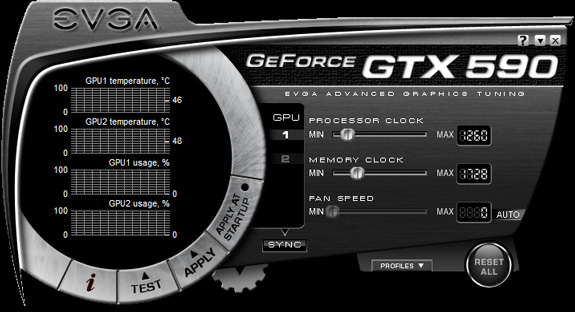
The next utility in EVGA’s suite is of course EVGA’s fantastic EVGA Precision overclocking tool. Based on the famous (and now discontinued) RivaTuner, Precision is a custom-skinned and up to date utility based on RivaTuner technology. It features per-GPU overclocking controls, an OSD overlay, and hardware monitoring/logging. Alongside MSI’s Afterburner, we believe it sets the gold standard for GPU overclocking/monitoring utilities.
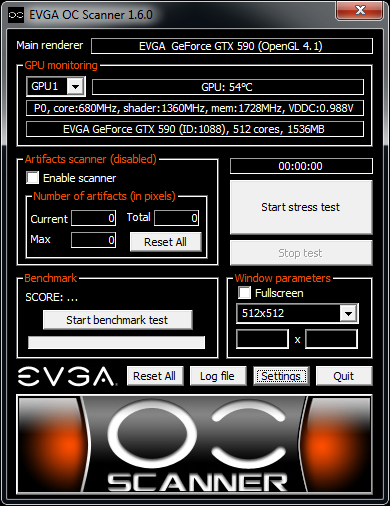
The final utility in EVGA’s suite is the EVGA Overclock Scanner. In a nutshell, the OC Scanner is a load-generating utility (ala Furmark) which rather than generating a moving image generates a static image. By generating a static image it’s possible for the software to identify any rendering errors in the image that would be indicative of a bad overclock. Or in other words, if you’ve overclocked your card too far, this utility will let you know. With the wider range of overclocking options afforded by ELEET, OC Scanner takes on an additional degree of importance for establishing both stability and safe operating temperatures, nicely rounding out EVGA’s software suite. All told the suite should cover 99.9% of most users’ overclocking needs.
Wrapping things up, as is customary for their high-end cards, EVGA is offering a lifetime warranty for the GTX 590, so long as the card is registered within 30 days. Notably overclocking does not void the lifetime warranty (this turned out to cause quite a bit of commotion with the 6990). Altogether, the entire EVGA GeForce GTX 590 Classified package has an MSRP of $729.


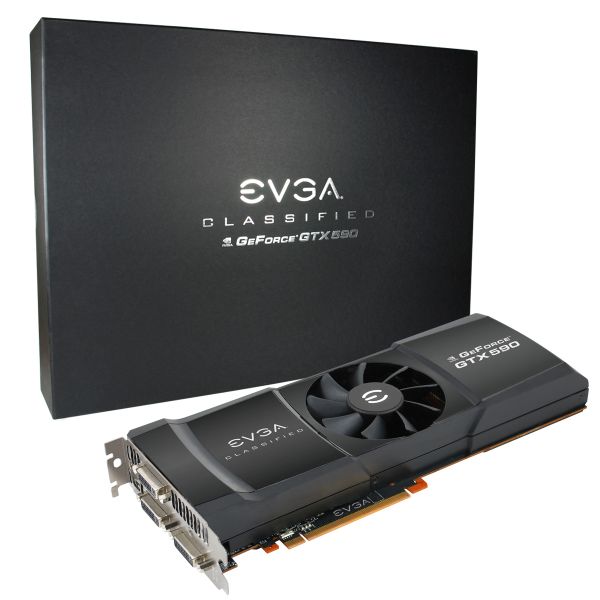
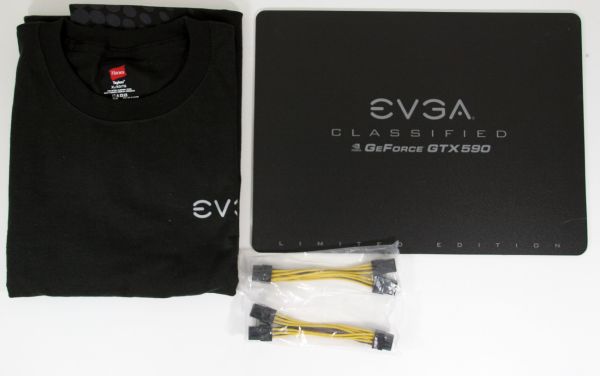








123 Comments
View All Comments
TalonP - Thursday, March 24, 2011 - link
First paragraph:"It really doesn’t seem like it’s been all that long, but it’s been nearly a year and a half since NVIDIA has had a dual-GPU card on the market. The GeForce GTX 295 was launched in January of 2009, the first card based on the 55nm die shrink of the GT200 GPU."
Well, shit. I thought Jan 2009 was TWO and a half years ago. I MUST GET BACK TO THE FUTURE!
strikeback03 - Thursday, March 24, 2011 - link
It was on the market after its launch. so if it disappeared somewhere at the end of 09/beginning of 10 that would match the "year and a half since on the market"RedemptionAD - Thursday, March 24, 2011 - link
Are there any reviews with such a setup out yet, or is it even supported? Maybe even a 3x or 4x setup? If it was a 4x 6990 setup or 590 setup could it rule the world?cjl - Thursday, March 24, 2011 - link
You can't go over 4 GPUs, so you can only SLI/CF two of the dual GPU cards.Nfarce - Thursday, March 24, 2011 - link
I'll be going with two 570's for the same price, thanks. And I can spread that pain at $350 per purchase over two months instead of one big $700 plunkdown.buildingblock - Thursday, March 24, 2011 - link
"....However the noise results are nothing short of remarkable – if NVIDIA can dissipate 350W+ of heat while at the same time making 5-7dB less noise, then it starts to become clear that AMD’s design has a serious weakness. The ultimate question is what did NVIDIA do right that AMD did not?...."I can't see anyone tolerating the noise level of the 6990. But the 590 is barely noisier than a 580. So an easy win for nVidia if you really need/can afford one of these monsters.
cactusdog - Thursday, March 24, 2011 - link
Ya, even the 6970/6950 are hot cards. Very disappointing after a very cool and silent 5870. I think AMD had a problem with the chips and never intended for them to be so hot. Maybe they had to crank up the power to get them to run right? idk...........Romulous - Thursday, March 24, 2011 - link
This card might be good for those people out there who love to cram as many GPUs into one box as they can and run folding at home.smigs22 - Thursday, March 24, 2011 - link
Major bias with the OC listing in the charts... the OC version is not enough... but a 20+% OC is included versus the other standard configs... and the lousy flip switch OC mode of 6990... not around 940/1400+ that other sites have attained.... that offers 6970CF+ performance :s ...Why dont they show 5870/6950/6970 CF & 470/480/570/580 SLI etc with appropriate 20%+ overclocks to put these cards in their place... especially with price vs performance.... the 2gb 6950s also having the ability to be flashed into 6970s too... not bad CF for price...The second fastest single card out there.... but still a beast and its kept its idle power within reason... i think its time for 28nm tech asap... as the carbon taxes on these bad boys will be horrendous...lol
BrightCandle - Thursday, March 24, 2011 - link
When you do the 3x monitor review can you please include last generations top end card (5970) for comparisons. Eyefinity and co is really where it is at with this monster graphics cards and in my experience the 5970 just doesn't have the horse power to play well at 5760x1200. I would really like to see how much difference these new cards and their increased RAM actually makes.50% performance compared to last generation at 2560 is OK, but do they get even more distance with the higher resolution?